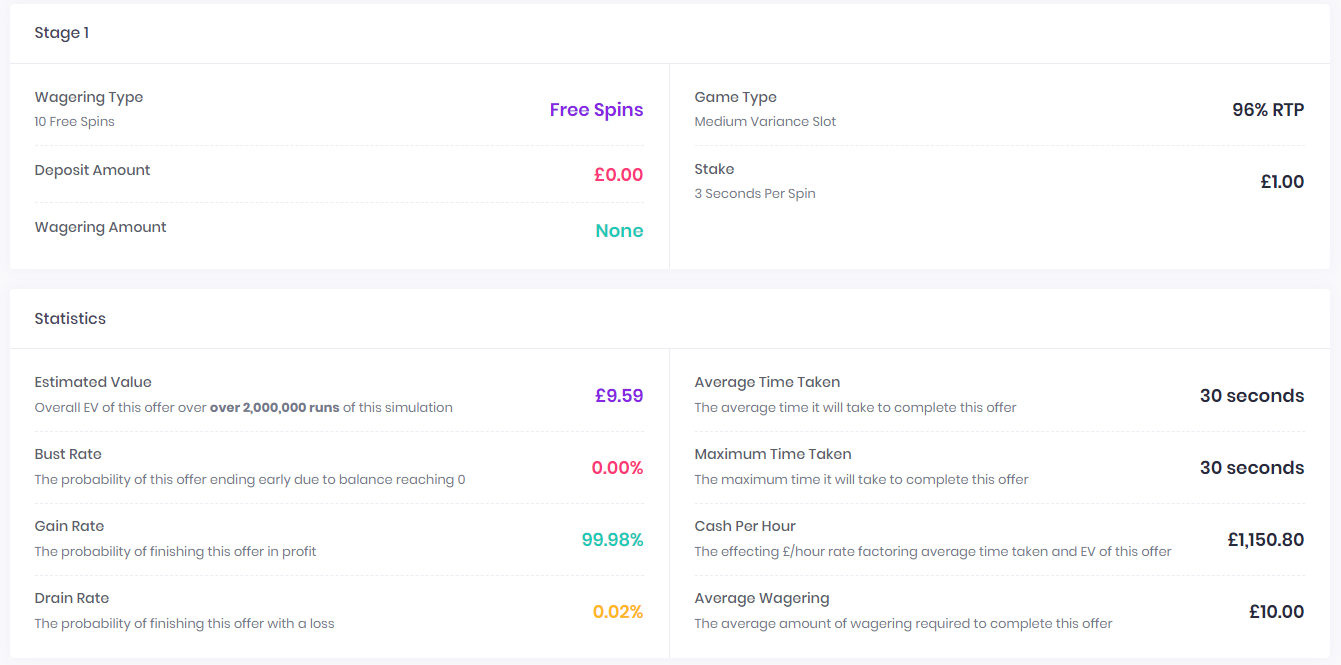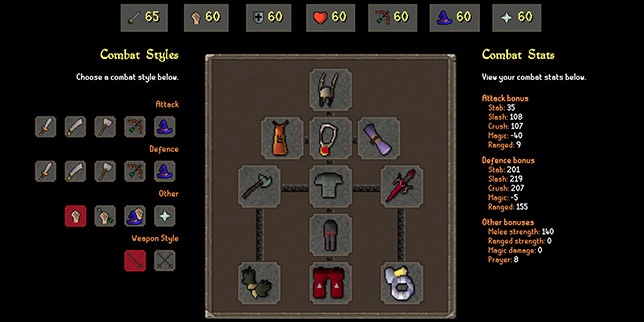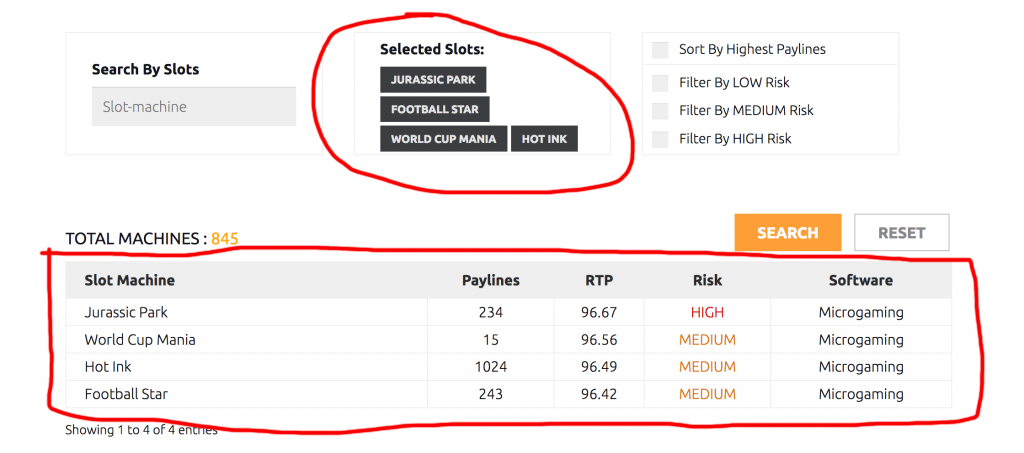- Slots Ev Calculator Price
- Slots Ev Calculator Monthly
- Casino Slot Ev Calculator
- Slots Ev Calculator Estimate
- Slots Ev Calculator Speed
On This Page
Introduction
The purpose of this calculator is to estimate the probability of ruin, given a positive expected value, standard deviation, bankroll, and infinite play. The calculator assumes the player flat betting and the odds of every trial are the same. The question the calculator answers is what is the probability the player would run out of money, as opposed to growing his bankroll forever. Here is some explanation of each field.
- Advantage — The player advantage of the bet. For example, in full pay deuces wild, which has a return of 100.762%, the player advantage is 0.00762. Please put the advantage in decimal form, as opposed to a percent.
- Standard deviation — The square root of the variance of each bet. For example, in full pay deuces wild this value is 5.08.
- Bankroll — If you lose every bet, this is the number of bets you could make before running out of money. In other words, the amount of money you can risk divided by the amount of each bet. For example, if you had $5,000 and were to play video poker at $1.25 a bet, your bankroll would be $5,000/$1.25 = 4,000.
- Risk of ruin — Leave this blank. When you click calculate the program will provide an estimate of the probability of running out of money. The alternative is growing the bankroll forever.
Disclaimer: This calculator produces an ESTIMATE only. The greater the bankroll size, the more accurate this estimate will be. In games like video poker, video keno, and slots, where the worst case scenario is losing one unit, I believe this calculator to overstate the chance of ruin.
From this point, BonusChum will speedily calculate the bust rate, EV (estimated value), and unique to this kind of software, the cash per hour and bankruptcy rate. Those final two stats are often overlooked, but are very important because your time is important, and so is the risk of bankruptcy.
- Slot EV Calculator This calculator enables you to calculate the EV on those offers which give Free Spins (FS) once you have wagered a certain amount. It does require you to know the value of the Free Spins if it is to give you an accurate EV calculation. RTPs for Commonly Used Slots.
- 100% Slot Ev Calculator Bonus: 20x wagering on combined deposit and bonus total (% game weightings and play restrictions apply). Max bonus bet £5 (£10 live casino) 15 days to accept, 40 to complete. £5 bonus: After deposit bonus wagered, selected games only. 1x wagering, 7 days to accept, 7 to complete, max withdrawal from winnings £100.
Internal Links
- Risk of ruin in blackjack (play requirement for a bonus situation)
The first line of The EV calculator is the “expected profit” Should I plug in $400? That’s the pot $240 + cbet of$160. Or just $240 (the pot) Second line of calculator – Is my expected loss $160 (the cbet)? Third – I expect to win 35%. My EV is = +$36? (that’s using expected profit of $400). I hit the 'Find Minimum EVs' button and see that it needs at least 280 EV's to survive Mega Mawile's Play Rough 100% of the time, so I know that my 'Available EVs' slot will need to be at least that. Step 4: Input Mega Charizard Y's specs into the Comparative Attack section.
External Links
- Risk of ruin at Wikipedia
- Risk of Ruin for Video Poker and Other Skewed-Up Games at Blackjack Forum Online.
Written by:Michael Shackleford
How many stops difference? What are the EV numbers? Find an Equivalent Exposure?
Want to know the value of f/6.3 + 1.67 EV of exposure?
There are three modes here:
- Enter two camera exposures to calculate EV Difference in exposures A and B.
- Or, find an Equivalent Exposure in B, to be equal exposure as specified in A.
- Find value of a ± EV value added to a shutter speed, f/stop, or ISO value at B.

The fields in this calculator work in nearest third or half stops, like the camera. If wanting to compare individual relationships (differences of two fstops, or shutter speeds, or ISO), then see another calculator.
This Calculator requires JavaScript be enabled in your browser.
Slots Ev Calculator Price
The selections above provide the possible camera settings. Half stops are marked with *½.
The calculator range of Nominals is large, but not quite infinite.
The f/stop range is f/0.5 to f/512 (20 EV range).
Shutter speed range is 2048 seconds (34 minutes) to 1/32000 second (26 EV range).
ISO is from ISO 1.56 to 3276800 (21 EV range). Seems adequate for photography.
The wide range prevents some equivalents of unsuitable settings from simply going out of range.
In the calculator:
- Option 1. The Settings EV is the computed EV for the two settings (shutter speed and f/stop). This computed EV is the exposure performed for whatever ISO that has caused the choice of these settings. Meaning, if assuming it is a proper correct exposure for the situation, it is the exposure that a light meter would read for that ISO. So ISO is definitely an EV factor, but like if a film camera, settings EV applies to whatever film speed is in the camera that caused selection of these settings. The exposure EV uses these settings AT THAT ISO. The set of the corresponding Equivalent Exposures are those on the row in the EV chart for that EV number.
Exposure Difference makes comparison of two exposures possible by first converting both EV results to ISO 100 (as if metered at the same ISO value). This arbitrary conversion to ISO 100 is called Light Value (next page). ISO 100 is Not magic nor unique nor special in any way in the EV system. We could have used any number, but ISO 100 is simply familiar and comfortable for us. ISO 100 is NOT special in any way, it's just a number, one among many, and only the popularity might make it seem special. It is simply convenient.
If the exposure difference is positive EV, then B is greater exposure, so the B Light Value EV100 is lower numerically (a lower light value needing the greater exposure). And vice versa.
- Option 2 changes a value in B be Equivalent Exposure of A. If the settings are already an equivalent exposure (0 EV difference), then of course no visible change will occur. If some half stop is mixed among the third stops, Equivalence can never be closer than 0.17 EV.
- Option 3 adds a plus or minus EV value to the value at B. The result will be rounded to nearest third or half stop, like the camera.
- Options 2 and 3 will only change the one setting specified. You must specify that one value to be changed at B. Options 2 & 3 will not change any setting until you are ready and click Compute. In contrast to Option 1 which updates at any change (but does not itself change any field). If that change is not in the range you prefer, a bit of trial and error with other manual adjustments can help to choose settings more optimized to your preference.
The camera settings EV term might be misunderstood, because it is computed from only the shutter speed and f/stop values (a calculator is on next page). This Settings EV is seemingly independent of ISO, except the EV number is computed from the camera settings already chosen for whatever appropriate ISO is in use, which makes ISO in fact be all important. Numerical EV was developed when light meters were to be added into film cameras (late 1950s) to aid computing exposure. Then film speed (called ASA then, ISO today) was a temporary constant determined by the roll of film in the camera. This ISO number was identified to the camera, so the metering knew it and could compute how much the camera settings needed to change to match exposure to this film speed. The settings combination of f/16 at 1/125 second is numerically EV 15 for any ISO, but of course, those settings are chosen and only applicable for the one specific ISO currently being used. So maybe the formula to calculate EV does not include the ISO number, but of course the choice of the proper camera settings used of course depends on ISO. The camera settings are not necessarily a correct exposure unless ISO does match them to the scene. More on next page (EV Chart).
The calculator default numbers represent full bright direct sunlight. The way the exposure is said is 1/2000 second at f/11 (EV 18) at ISO 800 (is EV 15100). An equivalent is also 1/125 second at f/16 (EV 15) at ISO 100 (is EV 15100), or other Equivalents of course, like 1/250 at f/11 at ISO 100 (also is EV 15100). All of these are the same exposure. However in practice, the EV number alone is not meaningful without specifying the corresponding ISO number.
That settings EV is that Exposure Value that a light meter would read when set to that ISO. It is how the EV Chart would be used, we would use the settings on that indicated EV chart row, for the proper metered exposure at that ISO (example next page). EV is technically computed from only the camera settings (only shutter speed and f/stop are computed), but those choices course depend on the ISO value. The one EV chart is for ANY AND EVERY ISO value, meaning specifically whichever chosen one is in use. If we change ISO, it changes the metered EV and the settings we would select.
ISO: That settings EV is the row in the EV chart where that combination of equivalent settings is found, and might appear to be independent of ISO in that way. However, when the light meter is set to an ISO and then it meters EV X, then the EV chart row X is the right settings for a correct exposure at that same ISO. ISO is of course very important. A different ISO would meter different settings on a different EV row. So the settings (shutter speed and f/stop) are selected with attention to the ISO (cause and effect), and certainly we do get a different EV with a different ISO.
Basically, the EV number is the 'name' of the set of Equivalent Exposure combinations of f/stop and shutter speed found on that one row of the EV chart.
Light Value converts the ISO to an arbitrary but standard ISO 100 value for the purpose to compare two actual exposures at the same ISO 100 values. The number 100 is NOT a special ISO number at all, Light Value could compare by converting both readings to any same ISO number, but 100 is merely a popular convenient number. Light Value represents the corresponding relative 'brightness level', so to speak, which then would require the appropriate proper corresponding exposure. More about Light Value on next page, and the formulas are on a math page. These are still the same two exposure levels (EV 18 at ISO 800 and EV 15 at ISO 100), but when both EV are converted to same ISO 100 for easy comparison, then here, both Light Values are EV 15100, or again, same light levels require Equivalent Exposures (at the same ISO 100). The Settings numbers may not have been Equivalent, but the resulting brightness level (adjusted for ISO) of the two Light Values of the exposures are the same, and Equivalent.
The calculator's initial default values of 1/2000 second and f/11 is EV 18 at any ISO. It is a correct exposure at only one ISO. Here, the exposure is specified as EV 18 settings at ISO 800. Set a light meter to ISO 800, and it would meter EV 18 here, and the EV Chart row (next page) for EV 18 will reflect the settings necessary for ISO 800. All columns of that row EV 18 are Equivalent Exposures.
The second 1/125 second at f/16 is EV 15 at any ISO. Here exposure is the EV 15 settings at ISO 100. Set a light meter to ISO 100, and it would meter EV 15 here, and the EV Chart for row EV 15 will reflect the settings necessary for ISO 100.
Which are Equivalent Exposures, because 1/2000 f/11 to 1/125 f/16 second is +3 EV more exposure, but ISO 800 to ISO 100 is -3 EV less exposure. This is a simple case, but the numbers can get more complicated.
Exposure Value and the EV Chart is covered on the next page. But either of the initial default settings above give the same equivalent metered exposure in typical bright sunlight. Both A and B are also the Sunny 16 Rule (except Sunny16 is often 1/3 stop more exposure than the EV system meters). The actual meter doing this is shown on next page. This is two actual real world meterings of two equivalent exposures.
Slots Ev Calculator Monthly
That concept is, for the two ISO values, the light meter reads EV 15 or 18. Look up either EV 15 or EV 18 in the EV chart, and it will show these settings appropriate for that ISO. That's what the chart's about. Since ISO 800 exposes 3 EV brighter, it offsets the faster shutter speed, so these two are Equivalent Exposures. The purpose of this calculator is to similarly compare any two exposures.

The calculators top 'EV (settings)' value is computed from the settings entered, and (assuming a correct exposure) is what a light meter will read at the working ISO, and this is the EV to look up in a EV chart for use at that ISO value. The actual camera setting choices will have already been affected by that ISO, so this EV is not further affected by the ISO that we enter now.
Casino Slot Ev Calculator
The entered ISO values (the working ISO actually used by the setting exposure) are used for the 'EV at ISO 100' values (often called Light Value), which simply converts both exposures from these values used, to be the same ISO 100, for purposes to compare the difference in the exposures for equality (ISO 100 is not a magic number, any SAME ISO value allows exposure comparison). The box above is organized its way to indicate that this ISO entry does not affect the top EV value again, but this ISO (now known) does affect converting to EV at ISO 100. The camera setting ISO used, and the calculator ISO entered, really must of course match for any reasonable use.
Slots Ev Calculator Estimate
 Specific example: The calculator defaults when this page loads are:
Specific example: The calculator defaults when this page loads are:A: 1/2000 second, f/11, for EV 18, but at ISO 800, it is Light Value EV 15.
B: 1/125 second, f/16 for EV 15, but at ISO 100 it is Light Value EV 15.
Settings EV (without effect of ISO), then EV of settings A is +3 EV more than settings B (EV is the combination of shutter speed and f/stop settings). EV of A is greater (EV 18) because the 1/2000 f/11 is less exposure of brighter light at higher ISO.
Slots Ev Calculator Speed
However Exposure Difference, if including ISO, then these two exposures are seen as Equivalent Exposures, because the higher ISO 800 of A compensates for its shutter speed. The EV 18 camera settings require +3 EV more ISO to be equal exposure of the EV 15 camera settings. Which of course it has that ISO here with ISO 800, so the exposures are seen Equal when adjusted to the same ISO 100 (EV100).

The Bottom Line at ISO100 shows 0 EV exposure difference (two equal exposures in this example).
There are more details about EV and LV on the EV chart next page.
Copyright © 2014-2020 by Wayne Fulton - All rights are reserved.